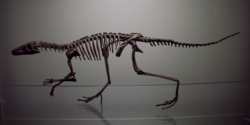恐龙形态类
爬行動物的演化支
恐龙形态类(学名:Dinosauromorpha)意为“恐龙”+“形态”,是一个鸟颈类主龙的演化支,包含恐龙与其近亲。恐龙形态类的基础物种包含:跳龙[1]、马拉鳄龙、兔鳄、兔蜥科、西里龙、伪兔鳄、塞龙、科技龙。
| 恐龙形态类 | |
|---|---|

| |
| 塔兰佩雅兔鳄(Lagosuchus talampayensis)的骨架复原模型 | |
| 科学分类 | |
| 界: | 动物界 Animalia |
| 门: | 脊索动物门 Chordata |
| 纲: | 蜥形纲 Sauropsida |
| 亚纲: | 双孔亚纲 Diapsida |
| 下纲: | 主龙形下纲 Archosauromorpha |
| 演化支: | 主龙型类 Archosauriformes |
| 演化支: | 镶嵌踝类 Crurotarsi |
| 演化支: | 主龙类 Archosauria |
| 演化支: | 鸟跖类 Avemetatarsalia |
| 演化支: | 鸟颈类主龙 Ornithodira |
| 演化支: | 恐龙形态类 Dinosauromorpha Benton, 1985 |
| 演化支 | |
马拉鳄龙、兔鳄、伪兔鳄、兔蜥科的兔蜥(Lagerpeton)生存于三叠纪卡尼阶的阿根廷。兔蜥科的Dromomeron生存于诺利阶的亚利桑那州、新墨西哥州、德州。西里龙生存于诺利阶的波兰[2][3]。塞龙生存于诺利阶的巴西[4]。科技龙生存于诺利阶的德州[5]。阿希利龙生存于安尼西阶的坦桑尼亚[6]。狄奥多罗斯龙(Diodorus)生存于诺利阶的摩洛哥,也可能是更早的卡尼阶[7]。鸟类是目前仅存的恐龙形态类。
在1984年,麦可·班顿(Michael J. Benton)建立这个分类单元。在1991年,保罗·塞里诺(Paul Sereno)将这个演化支定义为:兔蜥、兔鳄、伪兔鳄、以及恐龙(包含现存鸟类)的最近共同祖先、以及其最近共同祖先的所有后代;另一种定义则是:在鸟颈类主龙之中,所有亲缘关系接近于恐龙,而离翼龙目较远的所有物种。在2005年,保罗·塞里诺做出另一个定义:包含家麻雀在内,而不包含古老翼手龙、鸟鳄、尼罗鳄在内的最大演化支。
大约在2亿4400万到2亿4200万年前,相当于三叠纪中期的安尼西阶,鸟颈类主龙演化出恐龙形态类。在2010年,波兰圣十字山发现三叠纪早期的足迹化石,可能属于恐龙形态类。这个名为“Sphingopus”的足迹化石,是种中型二足动物,地质年代相当于2亿4600万年前。如果属实,恐龙形态类起源可追溯至奥伦尼克阶早期。在二叠纪-三叠纪灭绝事件之后,恐龙所属演化支可能很快就出现,但经历很长时间才演化成三叠纪后期的恐龙[8]。
参考文献
编辑- ^ Saltopus, a dinosauriform from the Upper Triassic of Scotland. Michael J. Benton and Alick D. Walker. Earth and Environmental Science Transactions of the Royal Society of Edinburgh / Volume 101 / Special Issue 3-4, pp 285 - 299 Royal Society of Edinburgh 2011 Published online: 17 May 2011 DOI:10.1017/S1755691011020081
- ^ Irmis, Randall B.; Nesbitt, Sterling J.; Padian, Kevin; Smith, Nathan D.; Turner, Alan H.; Woody, Daniel; and Downs, Alex. A Late Triassic dinosauromorph assemblage from New Mexico and the rise of dinosaurs. Science. 2007, 317 (5836): 358–361. PMID 17641198. doi:10.1126/science.1143325.
- ^ Nesbitt, Sterling J.; Irmis, Randall B.; Parker, William G.; Smith, Nathan D.; Turner, Alan H.; and Rowe, Timothy. Hindlimb osteology and distribution of basal dinosauromorphs from the Late Triassic of North America. Journal of Vertebrate Paleontology. 2009, 29 (2): 498–516.
- ^ Ferigolo, J.; and Langer, M.C. A Late Triassic dinosauriform from south Brazil and the origin of the ornithischian predentary bone. Historical Biology. 2006, 19 (1): 1–11 [2010-02-04]. (原始内容存档于2019-09-19).
- ^ Nesbitt, Sterling J.; Irmis, Randall B.; and Parker, William G. A critical re-evaluation of the Late Triassic dinosaur taxa of North America. Journal of Systematic Palaeontology. 2007, 5 (2): 209–243. doi:10.1017/S1477201907002040.
- ^ Nesbitt, S.J.; Sidor, C.A.; Irmis, R.B.; Angielczyk, K.D.; Smith, R.M.H.; and Tsuji, L.M.A. Ecologically distinct dinosaurian sister group shows early diversification of Ornithodira. Nature. 2010, 464 (7285): 95–98. PMID 20203608. doi:10.1038/nature08718.
- ^ Christian F. Kammerer, Sterling J. Nesbitt, and Neil H. Shubin (2011) The first basal dinosauriform (Silesauridae) from the Late Triassic of Morocco. Acta Palaeontologica Polonica (in press) doi:10.4202/app.2011.0015[1] (页面存档备份,存于互联网档案馆)
- ^ Brusatte, S.L.; Niedźwiedzki, G.; and Butler, R.J. Footprints pull origin and diversification of dinosaur stem lineage deep into Early Triassic. Proceedings of the Royal Society B. 2010, 278 (1708): 1107–1113. PMC 3049033 . PMID 20926435. doi:10.1098/rspb.2010.1746.